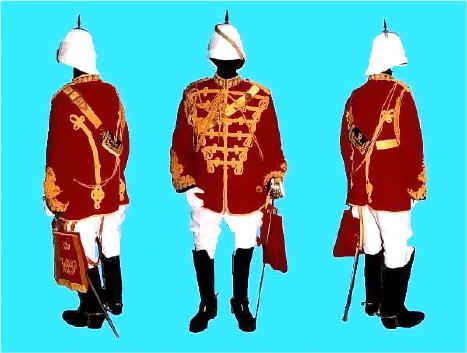|
"Viceroy's Bodyguard - India 1890"
This is the Dress uniform of a British field officer (Major) in His Excellency the Viceroy’s Bodyguard – India 1890 and has been the subject of several well-known paintings by Simpkin and Fry amongst others. (Click on artist’s name to see painting). It should be noted that the Simpkin painting shows the sabretache facing- colour to be blue whereas it should be correctly shown as red.. The Bodyguards were special troops formed to accompany and protect the Governor-General or Viceroy. Previous to September 1762 cavalry did not exist in the Bengal establishment, and in that month the European section of the army supplied two troops of Dragoons and one troop of Hussars for special duties. The hussars, who were to act as actual bodyguard, comprised one lieutenant, one cornet and thirty-six other ranks. After being disbanded in 1765, the troop was re-formed in 1773 by Warren Hastings and when he became Governor-General they became known as the Governor-General’s Bodyguard. During the following years numbers were increased and Infantry and Artillery sections were added together with a mounted band. After the mutiny, when Lord canning became Viceroy, the Bodyguard was known as His Excellency the Viceroy’s Bodyguard. The Bodyguard did not just act as ceremonial troops but took an active part in many campaigns from its earliest days, and this is reflected in the battle honours shown on their various appointments. The uniforms varied and evolved over the years until in 1886 the Dress regulations detail the final result, at least for our late Victorian period. The scarlet tunic is cut as for Hussars with a blue cloth collar and cuffs trimmed as Hussars with gold gimp. The white helmet had a simple white muslin turban or pugri and a gilt spike and chin-chain White pantaloons and Napoleon boots were worn when mounted, as were blue cloth overalls with a double gold oak-leaf stripe, when dismounted.. The sword belt was gold oak-leaf lace on scarlet morocco leather with gilt buckles, and a silver waist-plate with gilt mountings. The sword and scabbard were regulation cavalry and the sword knot gold with acorn. The pouch-belt was also gold oak-leaf lace on scarlet morocco leather with gilt buckle, slider and tip, prickets and chains. The pouch was gold embroidery and gold braid on blue cloth and blue morocco leather with gilt ends and fastenings. The aiguillette was gold and the gloves white leather. The scarlet morocco leather sabretache had gold embroidery and oak-leaf lace on a scarlet cloth face. The embroidery contained a VRBG cypher with a large Hanoverian crown together with the battle honours – MAHARAJPORE; MOODKEE; FEROZSHUHUR; ALIWAL and SOBRAON. |
![]()
Thin
Red Line
Thin Red Line,
PO Box 65,
Seavington,
Ilminster,
TA19 0WE. UK
